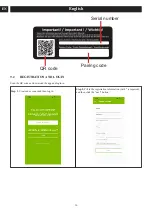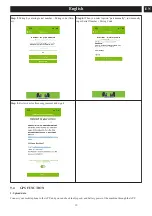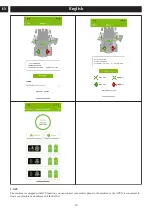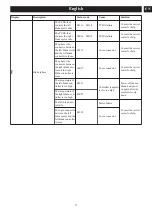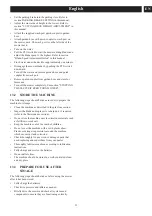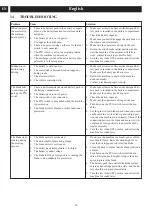
11
MAINTENANCE
Regular maintenance is the best prevention for costly
downtime or expensive, premature repair. The following
pages contain suggested maintenance information and
schedules which the operator should follow on a routine
basis. For more detailed information, refer to the website for
your unit. Remain alert for unusual noises, as they could be
signaling a problem. Visually inspect the machine for any
abnormal wear or damage.
11.1
TIRES
It is important for level mowing that all tires have the correct
amount of air pressure. The recommended pressure are:
NOTE
Tire pressure should only be measured or adjusted when
tires are cold.
Drive wheels
8 psi
Front caster wheels
24 psi
NOTE
Inspect the tires daily. Replace immediately if damaged.
WARNING
Check the tire pressure carefully while inflating. Too much
air in the tire could cause the tire to burst, causing serious
personal injury.
11.2
MOWER BLADE MAINTENANCE
Check the mower blades daily. They are the key to power
efficiency and well-groomed turf. Keep them sharp -- a dull
blade will tear rather than cut the grass, leaving a brown
ragged top on the grass within a few hours. A dull blade also
requires more power. Replace any blade that is bent, cracked
or broken.
WARNING
Never attempt to straighten a bent blade by heating, or weld
a cracked or broken blade as the blade may break and cause
serious injury. Replace worn or damaged blades.
WARNING
Never work with blades while key is in the ignition switch.
Turn key to “OFF” position, remove key from switch and
disconnect battery cables by pulling inward on RED battery
quick disconnect handle in battery box compartment. Block
up mower when you must work under it. Wear gloves when
handling blades. Always check for blade damage if mower
strikes a rock, branch or other foreign objects!
DANGER
The blade adapter will come off when the blade cap screw
is removed. Touch-up sharpening can be done with a file.
Check the blades for balance following grinding. A
commercial balancing tool is available through most
hardware supply stores, or balancing can be done by placing
the blade on an inverted line punch or 1/2" bolt. Blade
should not lean or tilt. While spinning the blade slowly, it
should not wobble. If blade is out of balance, true it up
before reinstalling. Lay the blade on a flat surface and check
for distortion. Replace any distorted blade.
WARNING
•
The blade sail (curved part) must be pointing upward
toward the inside of the deck to ensure proper cutting.
•
When mounting blades, rotate them after installation to
ensure blade tips do not touch each other or sides of the
mower.
•
Failure to correctly torque the bolt may result in the loss
of the blade, which can cause serious injury.
•
Mower blades are sharp and can cut. Wear gloves and
use extra caution when servicing them.
11.2.1 REPLACE THE BLADE
Blade
Washer
Bolt
1. Stop the motor, remove the start key, and set the parking
brake.
2. Raise the height of the cutting deck to its highest position
to allow access to blades.
NOTE
If necessary, raise the mower by placing on a lift or
using a jack and jack stands, or remove the cutting deck
as described in the previous section to gain access to the
blades.
WARNING
If raising the mower to access the blades, make sure the
mower is properly secured and the parking brake is set
before proceeding. Failure to properly secure the mower
could cause it to fall, resulting in death or possible
serious personal injury.
3. Wedge a block of wood between the blade and mower
deck to prevent the blade from turning.
29
English
EN


